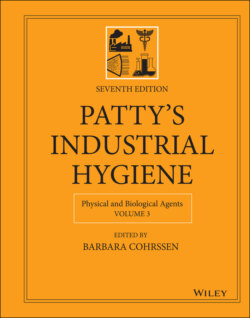Читать книгу Patty's Industrial Hygiene, Physical and Biological Agents - Группа авторов - Страница 20
3.2 Radioisotopes
ОглавлениеThe Bohr atomic model describes the atom as a positively charged central nucleus surrounded by electrons that revolve around the nucleus in specific radii, and are bound to the nucleus by the attractive electrical force between the positively charged nucleus and the negatively charged electron. The nucleus contains positively charged protons and electrically neutral neutrons. The attractive nuclear force between neutrons and protons and between neutrons acts to overcome the repulsive forces among the positively charged protons.
The atomic number, and hence the chemical nature of the element, is determined by the number of protons within the nucleus. While the number of protons may remain constant, most of the naturally occurring elements consist of nuclei that have differing numbers of neutrons. Nuclei of the same element that have different numbers of neutrons are called isotopes. Copper, for example whose atomic number is 29, is a mixture of two isotopes. About 69% of Cu atoms contain 34 neutrons, and hence has 63 particles (nucleons) within its nucleus, and about 31% have 36 neutrons, or 65 nucleons in the nucleus. The number of nucleons is called the atomic mass number. Symbolically, isotopes are written with the chemical symbol and the atomic mass number as a superscript to the left of the symbol: 63Cu and 65Cu in the case of copper 63 and copper 65, respectively. For an isotope to remain stable, the neutron/proton ratio must lie within a relatively narrow range. If the ratio is outside this range, the nucleus is unstable and achieves stability through a spontaneous nuclear transformation that corrects the neutron/proton ratio. Such an unstable isotope is called a radioisotope. Radioisotopes emit various combinations of particles and gamma rays that are specific to each isotope; this process is called radioactive transformation or radioactive decay. In most cases, the transformed nucleus is a different element, one whose neutron/proton ratio is closer to stability than the unstable parent's nucleus.
All radioisotopes are uniquely identified by a set of three different characteristics:
Type of radiation that is emitted
Energy of the emitted radiation
Rate at which the radioisotope decays. This rate is described either by the half‐life, or by the fraction that decays per unit time (the decay rate constant).
